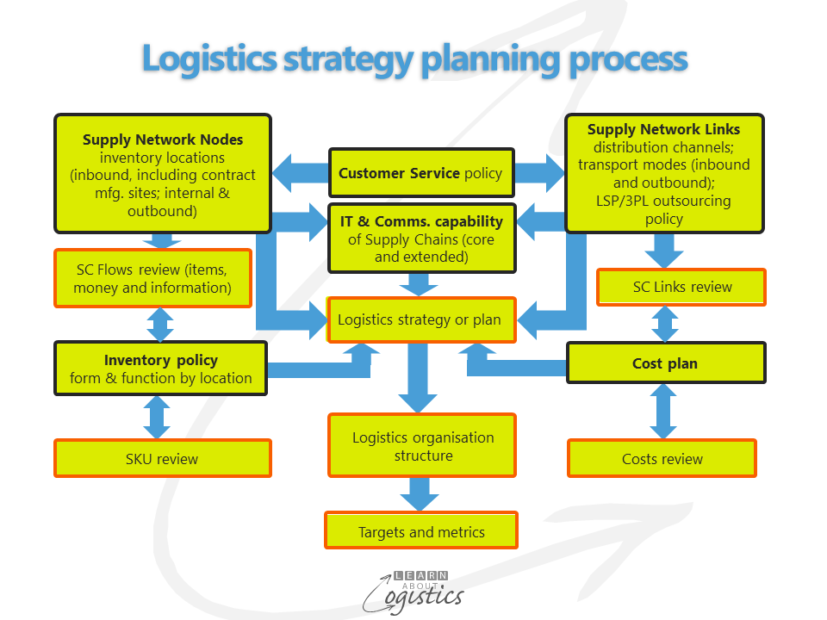Logistics Strategy relies on the Business Plan.
Logistics, like other functions in your organisation requires a plan to operate against. Importantly, it should be a part of the One-Plan process shown in the diagram, whereby each stage of planning is linked to others, so there is traceability of information and data. To start the Logistics Strategy planning process, the inputs are the Business Model, Business Plan and external information.
The post ‘Your Business Model will influence the Business Plan’, discusses the Business Model (also called the Corporate strategy). This peak element of the One-Plan process for your organisation, provides an overview of the enterprise and its reasons to exist. The Business Model defines the industry type(s) in which the organisation is engaged, the types of businesses operated, how the enterprise views its markets, the geographical reach, how responsibility for sales and profit is structured and the allocation of investments.
The Business Model and external information are the two main inputs to the Business Plan (also called the Business Strategy), which identifies the markets, customers and competitors for your organisation. The next step in the planning process is to use the Business Plan as input to the Function strategies; these identify how each function will contribute to the Business Plan. The main functions are Marketing, Finance and the three functions of Supply Chains – Procurement, Material Conversion and Logistics.
Convert Marketing needs to Supply Chain resources
Knowing about the markets your organisation serves is the domain of Marketing. However, the three Supply Chain functions must also have a market perspective of what they do, to enable the best mix of resources to be provided. Achieving this requires an ability to convert Marketing requirements into Supply Chain resources. Starting with the product groups designated by Marketing, two methodologies are used to make the conversion:
- Identify the competitive advantage for each product group, based on time and place utilities
- Identifying the ‘order qualifiers and winners’ to reconcile the requirements of end user markets with Supply Chain resources
Time and place has five attributes that define availability (the objective of Logistics) and are the basis of Supply Chain competitiveness. The attributes defined by Slack et al. Operations Management (2004) are:
- Speed: minimising the time between a customer enquiry and their receipt of the items
- Quality of the process: satisfy customers by providing items that are ‘fit for purpose’ and ‘error free’
- Flexibility: respond to customer’s needs at short notice through adapting or varying product/service, product mix, volume and delivery activities
- Dependability: consistently provide ‘delivery in full, on time with accuracy’
- Cost: provide items at a cost that enables customers to meet market expectations for price
The scope of each attribute can be constrained by the level in a Supply Chain occupied by the organisation, where the enterprise is located, together with the storage and ease of handling for the materials.
Order Qualifiers and Winners are based on the product groups defined by Marketing. The Order Qualifiers are those factors that a market segment regards as the base performance requirements which must exist for the organisation to be considered for an order. Order Winners are the factors that are significant enough for customers to view them as key reasons to buy items. Order Qualifiers and Winners can be influenced by the activities of competitors and the stage in the life cycle of the item (introduction, growth, maturity or decline).
Logistics Strategy planning process
Having converted Marketing requirements to Supply Chain resources needs, each of the three functions within Supply Chains can develop their own strategy, or plan. It is only when the three functional plans are completed are they combined into a Supply Chains strategy. An example of one function is the Logistics Strategy plan:

There are three main steps to review the background and current Logistics situation:
- Specific Logistics factors about products that influence the design of each supply chain:
- Volume : weight ratio of the item
- Value : weight ratio of the item
- Availability – the lead time required by the customer or end user, therefore requirements concerning delivery and inventory
- Product security risk issues with an item:
- Perishable
- Contamination
- Flammable/explosive
- High value/theft potential
2. Consideration of each product group to identify:
- how close to markets or materials the product should be made
- geographic location where products will be made or sourced
- how products will be moved and stored
- the modes of transport to use
3. Four reviews: Supply Chain flows; items (SKUs); Supply Chain links and costs
Within the review process of nodes and links is the outsourcing policy. This is the extent to which an enterprise will ‘make’ (do something within the business) or ‘buy’ (contract another party to do something). It includes the policy regarding Logistics service providers (LSPs), which includes third party logistics (3PL) providers. While outsourcing may be treated as an operational transaction, strategically it relates to decisions concerning the degree of vertical integration within an enterprise. Within the outsourcing policies will be considerations about off-shoring, near-shoring and in-sourcing (returning outsourced activities to in-house).
The Logistics Strategy plan is then developed within eight elements:
- Customer service policy – the appropriate level of service for customers, by product group or market segment; considering: order fulfilment requirements, enquiry and investigation capability and the available information. The customer service policy informs the nodes and links of the supply network
- Inventory location policy (Supply Network nodes) – centralised or decentralised inventory; whether to differentiate facilities by fast and slow moving stock; location of sites; use of specific technologies and layouts; company-owned or contracted facilities
- Inventory policy – form and function of inventory by location; the appropriate amount of stock to hold for various groups of inventory; planning structure that links outbound and inbound materials
- Cost plan – trade-off analysis between cost and service level requirements; cost of Logistics operations
- Transport and distribution (Supply Network links) policy – affected by whether enterprise imports or exports and the size and structure of conurbations being served. This incorporates transport modes, delivery pattern and storage location considerations, based on the time taken for deliveries.
- IT and Communications capability: technologies (including software) that will be internally developed; buy planning and scheduling applications from single supplier or obtain ‘best of breed’ applications
- Logistics organisation structure: function or flow based; allocation of responsibilities; managed or self-managed teams
- Logistics Targets and metrics: measures of performance and achievement targets; operations improvements process and management
Similar processes are followed to develop the Procurement strategy and Materials Conversion strategy. These will be discussed in future posts.
Note for readers: I will be travelling in remote Australia for a few weeks. New posts will re-commence on September 14. While I am away, previous posts will be repeated via Twitter #supplychain, # procurement, #logistics. Thank you for opening my posts and I trust that Learn About Logistics is of benefit in your learning about this challenging part of organisations.

